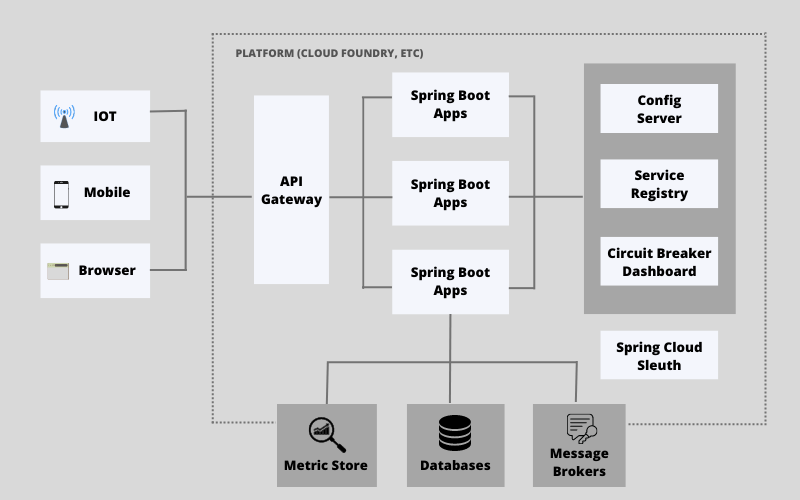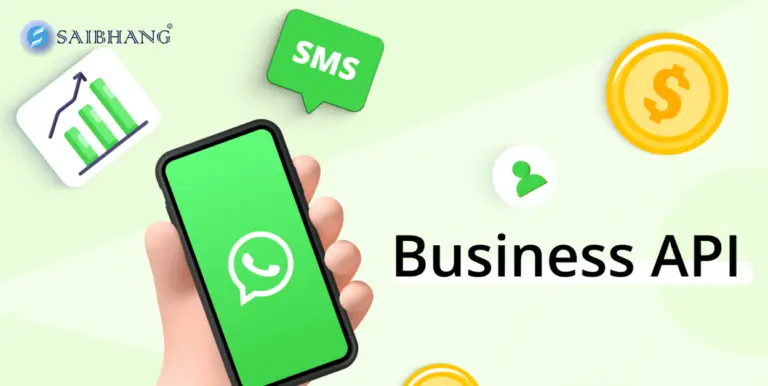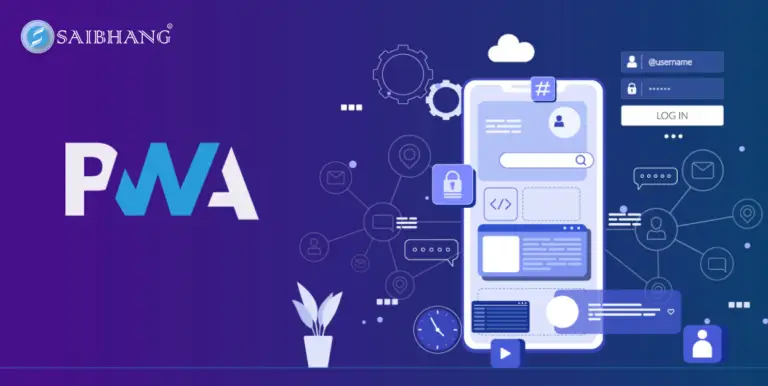Which are the Top 10
Microservices Frameworks?
Making a business application plan After choosing the type of application you want, one of the first things you do is design the architecture. You wind up reading success stories of Fortune 500 or other top-performing firms from around the world, and you discover how they were able to change their system by utilizing a microservices design. When you read headlines like, By switching from a monolithic design to microservices, companies like Netflix, Amazon, Uber, and Etsy are scaling to new heights.
And this is precisely the time when you thought that microservices had unlimited power.
The first step in the process is for developers to pick the appropriate framework that has all the integrated capabilities needed to create a successful and highly performant app. These frameworks also determine the cost, time, and convenience of handling throughout development as well as long-term maintenance.
1. Spring Boot or Spring Boot with Spring Cloud
Spring Boot is a popular Java framework for developing Microservices applications. For creating microservices architecture, Spring Cloud provides a wide range of add-on modules. Large distributed systems can be built with Spring Boot by starting with a simple design that consists of several interdependent components. It can be used to build both small and big systems. Reversal of Control makes Spring boot reasonably simple to integrate with other well-known frameworks.

Key Advantages:
- The construction of dynamic microservices programs using REST API is made possible by Spring MVC.
- Interfacing with leading frameworks is made simple via inversion of control.
- The micrometer is an extra framework for distributed monitoring, analytics, and tracking of important data.
- For horizontal scalability and seamless integration of many backend services, Cloud Foundry is used.
- Improvement in time-to-market for complex application architecture.
We use microservices as they advocate for best practices in big data. A data pipeline-oriented architecture, which is in line with how large data should be gathered, digested, processed, and distributed, naturally fits microservices. A microservice is a little task that is handled by each step in a data pipeline.
2. Eclipse Vert. X
Eclipse Vert. X can be your first choice if you’re looking for event-driven microservices solutions for software development. It offers support for a number of languages, such as Java, Ruby, Kotlin, Ceylon, JavaScript, Groovy, and Scala. The framework is a suitable choice for service-oriented projects with complex microservices architecture because it runs on a Java Virtual Machine.
They are comparatively simple to construct and maintain. They may be constructed and maintained by smaller teams due to their single-purpose design. Each team can specialize in a portion of the microservices in a solution while also being cross-functional.
Vert. X from the Eclipse Foundation, in contrast to traditional stacks and frameworks, has resource-efficient characteristics that enable it to handle several requests at once. It is capable of doing duties in confined spaces, particularly containers. Due to its features and embedded characteristics, which make it more of a flexible tool than a framework, Vert. X is often used as a microservice framework.
Key Advantages:
- With a 650kb foundation, it is compact.
- Because of its flexibility, developers can incorporate as many components as they need without introducing extraneous material.
- Executing medical tests using Vert. X web or an event bus is simple.
Using Vert. XUnit, asynchronous unit tests are run. - According to the software code provided by Google, it supports PRC.
3. Oracle Helidon
Helidon, a microservices framework, was made by Oracle. A collection of Java libraries are used to create microservices. The two options are Helidon MP and Helidon SE. Helidon is inferior to Helidon in a lot of respects, although Spring Boot is better. Helidon is still in its infancy, and the lack of documentation makes it challenging to get answers on Stack Overflow.
A MicroProfile standard implementation is called Helidon MP. Because of this, it’s a great choice for Java EE programmers. A compact toolkit called Helidon SE supports the newest Java SE capabilities, such as reactive streams, asynchronous and functional programming, and fluidly designed APIs. For low storage usage and a startup that mimics a flash drive, Helidon SE delivers native GraalVM files. Based on Netty, Helidon SE’s REST framework offers a straightforward API for handling sessions.
Saibhang uses these because they allow for better-quality coding. Application development teams benefit from being able to concentrate on one minor aspect at a time by modularizing a larger solution into distinct components. This streamlines the entire process of testing and coding.
Key Advantages:
- There is a minimum starting time that ranges from 0.09 to 2.03 seconds.
- Includes a complete cloud environment with all necessary and widely used technologies.
- Consists of the Helidon SE and Helidon MP versions for different programming requirements.
4. GoMicro
A modular RPC-based framework called Go Micro provides the fundamental building blocks needed to create microservices using the Go programming language. It offers Pub/Sub, HTTP networking, proto-RPC or JSON-RPC encryption, and service discovery using the consul.
They make cross-team coordination simpler. Microservices use event-streaming technologies to facilitate quicker integration, in contrast to standard service-oriented architectures (SOAs), which often need complex inter-process communications protocols.
Go Micro satisfies the necessary requirements for creating scalable systems. It transforms the microservice architectural pattern into a group of tools that act as the framework of the system. Micro gives programmers straightforward representations they are already familiar with while addressing the challenges of parallel computing.
Technology is constantly changing. Stacks of infrastructure are always changing. A modular toolkit called Micro addresses the aforementioned issues. Connect any key technology or foundation to the system. Utilize micro to build solutions for the future.
Key Advantages:
- The micro API makes it possible to serve protocols like HTTP, GRPC, and WebSockets, and publish events, among others, through discovery and modular processors.
- The CLI offers every feature required to understand the state of your microservices.
- Create fresh application templates to get going quickly. Micro provides pre-made templates for the creation of microservices. Always start the same way and create comparable offerings to boost productivity.
5. Molecular
A fascinating microservices framework is molecular. This framework is perfect for JavaScript developers as NodeJS grows in popularity. A powerful, modern, and speedy NodeJS microservices framework called Molecular. It makes it easier to develop dependable, effective, and accessible services.
Key Advantages:
- Support for event-driven infrastructure must be balanced.
- Integrated services registry and adaptive service discovery
- Queries and replies that are load-balanced
- A variety of fault-detecting traits
- An integrated caching strategy
- Modular displays
- Metrics that are integrated with report generators
- Integrated exporter tracing capabilities
6. Quarkus
Quarkus microservices technology has been endorsed by Kubernetes enthusiasts! A Kubernetes-native JS framework made exclusively for OpenJDK HotSpot and GraevalVM is Red Hat’s Quarkus. The framework offers a dynamic and impulsive programming methodology to address the architectural challenges of microservices.
Kubernetes is intended to maximize quick developer setup and minimum memory usage. Microservices and Kubernetes can scale automatically due to the rapid launch time.
Low memory usage enables microservices, which independently launch several containers, to optimize container capacity. However, because of the challenging GraalVM setup and OS-specific binary verification of this framework, inexperienced programmers are wary of using it.
One advantage of the Quarkus development paradigm is that it integrates well with serverless architectural systems, reactive programs, and HTTP microservices. The efficiency of developers is greatly improved by their straightforward traits and easily understandable structure, which focuses on the business aspect of the entire software. Additionally, consistent configurations, live programming, DEV UI, and test automation enhance developers’ microservice development experiences.
Key Advantages:
- Has a wide range of technologies, frameworks, and APIs, which makes it easy to comprehend and use.
- It is a generational framework that enhances the native script and JVM coding to boost application performance.
- It claims faster load times as compared to other container-first frameworks.
- Low RSS memory and excessive memory usage.
7. Micronaut
A modern JVM-based full-stack framework called Micronaut is designed to help create adaptive and simple-to-test microservices applications.
The developers of the Grails framework, who also created Micronaut, were inspired by their earlier experiences using Spring, Spring Boot, and Grails to build real-world systems that ranged in size from monolithic to microservices.
The resources needed to build fully working microservice apps will be made available by Micronaut.
Key Advantages:
- Injection of Dependencies and Inversion of Control (IoC)
- Automatic Settings and Adaptive Default
- Service Identification
- Routing HTTP
- HTTP Client with client-side load balancing
8. Lightbend Lagom
Lagom is an open-source framework for creating microservices applications in Java or Scala. Lagom is built on Akka and Play, two well-known, cutting-edge technologies that are already in use for a handful of the intended applications.
You may concentrate on resolving business difficulties rather than linking services thanks to Lagom’s unified development ecosystem. The project is created, your microservices and supporting modules are run, and the Lagom architecture is booted all in one action. The build is instantly reloaded when it discovers source code changes.
Key Advantages:
- Specified development tasks are necessary to increase nimbleness.
- To lengthen development cycles, more frequent launches with reduced risk are preferred.
- Systems include reactive characteristics including reactivity, robustness, adaptability, and flexibility to meet high user demands and maximize present computer settings.
9. AxonIQ
Axon offers a single, effective technique for creating Java programs that can change without requiring extensive modification.
In order to provide business-ready support for the software system, in particular for the corporate software development process, Axon comprises both a software system and a specific architecture. Model and architecture are provided by Axon Framework and Axon Server, respectively. Each one is cost-free.
Key Advantages:
- It is a Java microservices framework that makes it easier to create microservices designs using concepts from domain-driven design.
- The Command-Query-Responsibility-Segregation (CQRS) and Architecture microservices paradigms, in addition to DDD, are supported by the Axon Framework.
- Even the most demanding business requirements can be met by Axon, including those for the most efficient scaling of data storage, encryption, networking, load-balancing, globally dispersed data centers, third-party interface, statistics, and analytics.
10. Ballerina
Not a framework, Ballerina is one of the programming languages for creating network applications. constructed specifically for writing disconnected services. Network apps are quite easy to make. With the help of this open-source coding language and framework, cloud-era app developers may create software that is easy to use and requires no work.
Multitasking, broadcasting, encryption, and native support for Microservices are some additional features.
Key Advantages:
- Language patterns are specific to receiving and delivering network services.
- To enable the bidirectional translation of the Ballerina source code between written and visual presentations, modules and language for asynchronous interaction that work well with sequence diagrams were developed.
- A type model for dynamic architecture that allows for looser coupling than traditional highly typed programs.
Recent Blog
-
 23 Jan 2025 App DevelopmentHow to Get a Blue Check for Your Email Organization
23 Jan 2025 App DevelopmentHow to Get a Blue Check for Your Email Organization -
![Supercharge Your Online Store's Sales with Proven Strategies (1)[1]](data:image/svg+xml;base64,PHN2ZyB4bWxucz0iaHR0cDovL3d3dy53My5vcmcvMjAwMC9zdmciIHdpZHRoPSI3NjgiIGhlaWdodD0iMzg2IiB2aWV3Qm94PSIwIDAgNzY4IDM4NiI+PHJlY3Qgd2lkdGg9IjEwMCUiIGhlaWdodD0iMTAwJSIgc3R5bGU9ImZpbGw6I2NmZDRkYjtmaWxsLW9wYWNpdHk6IDAuMTsiLz48L3N2Zz4=) 13 Jul 2024 App DevelopmentSupercharge Your Online Store's Sales with Proven Strategies
13 Jul 2024 App DevelopmentSupercharge Your Online Store's Sales with Proven Strategies -
![How to Review Google Ads Performance[1]](data:image/svg+xml;base64,PHN2ZyB4bWxucz0iaHR0cDovL3d3dy53My5vcmcvMjAwMC9zdmciIHdpZHRoPSI3NjgiIGhlaWdodD0iMzg2IiB2aWV3Qm94PSIwIDAgNzY4IDM4NiI+PHJlY3Qgd2lkdGg9IjEwMCUiIGhlaWdodD0iMTAwJSIgc3R5bGU9ImZpbGw6I2NmZDRkYjtmaWxsLW9wYWNpdHk6IDAuMTsiLz48L3N2Zz4=) 27 Jun 2024 Digital MarketingHow to Review Google Ads Performance
27 Jun 2024 Digital MarketingHow to Review Google Ads Performance -
![Simplifying Software Development with Docker _ Unraveling Its Benefits (1)[1]](data:image/svg+xml;base64,PHN2ZyB4bWxucz0iaHR0cDovL3d3dy53My5vcmcvMjAwMC9zdmciIHdpZHRoPSI3NjgiIGhlaWdodD0iMzg2IiB2aWV3Qm94PSIwIDAgNzY4IDM4NiI+PHJlY3Qgd2lkdGg9IjEwMCUiIGhlaWdodD0iMTAwJSIgc3R5bGU9ImZpbGw6I2NmZDRkYjtmaWxsLW9wYWNpdHk6IDAuMTsiLz48L3N2Zz4=) 22 May 2024 Software Design and DevelopmentSimplifying Software Development with Docker : Unraveling Its Benefits
22 May 2024 Software Design and DevelopmentSimplifying Software Development with Docker : Unraveling Its Benefits -
 06 May 2024 WhatssHow WhatsApp Business API Enhances Communication for Businesses
06 May 2024 WhatssHow WhatsApp Business API Enhances Communication for Businesses -
 16 May 2023 App DevelopmentHow to Build (PWA) Progressive Web App
16 May 2023 App DevelopmentHow to Build (PWA) Progressive Web App -
 31 Jan 2023 PPCPPC Advertising Highly Effective Way to Drive Traffic to a Website
31 Jan 2023 PPCPPC Advertising Highly Effective Way to Drive Traffic to a Website




![Supercharge Your Online Store's Sales with Proven Strategies (1)[1]](https://saibhang.io/wp-content/uploads/2024/07/Supercharge-Your-Online-Stores-Sales-with-Proven-Strategies-11-768x386.webp)
![How to Review Google Ads Performance[1]](https://saibhang.io/wp-content/uploads/2024/06/How-to-Review-Google-Ads-Performance1-768x386.webp)
![Simplifying Software Development with Docker _ Unraveling Its Benefits (1)[1]](https://saibhang.io/wp-content/uploads/2024/05/Simplifying-Software-Development-with-Docker-_-Unraveling-Its-Benefits-11-768x386.webp)





